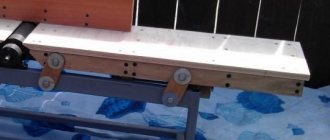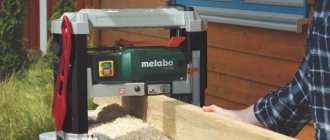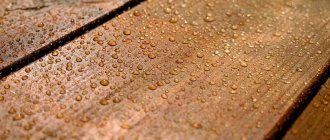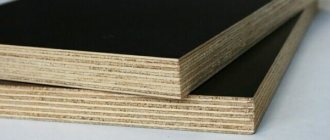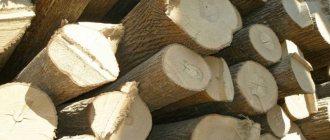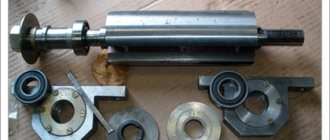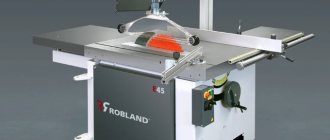In industrial enterprises where lumber is regularly processed, the main type of equipment is considered to be a woodworking jointer. It is also installed in private and carpentry workshops.
Recently, jointing equipment has been purchased by home craftsmen engaged in the manufacture of wooden products.
This device is good because it is easy to use, and the cuts are high-quality and accurate. Similar results can be achieved thanks to the built-in guide bar.
Types of jointing machines
Manufacturers offer two types of jointing machines : single-sided and double-sided.
- Single-sided machines. The equipment is used for jointing boards and timber up to 1.5 m long. The workpieces are fed manually at a speed of up to 10 m/min. In one pass, the device is capable of treating only one surface. The single-sided jointer can be operated by one operator.
- Double sided machines. Having a special design, double-sided jointing machines are capable of processing two adjacent parts at once in one pass. They are equipped with an automatic feeder roller and are convenient in that they allow you to select the desired grooves and reveals during operation. This equipment can be operated by several workers.
Why do we need thicknessing and jointing machines?
Among woodworking machines, the category of longitudinal milling machines stands out, which include jointers and thickness planers.
With their help, you can process lumber for finishing. The machines remove all types of defects if they arise during wood processing. For them, you need to take only wood that has been well dried. How do these types of tools differ from each other, and for what purposes is it best to use jointing machines, and for which thicknessing machines?
For boards, panels and bars it is necessary to use thicknessing machines. They allow you to plan materials of a certain size, focusing on the desired thickness of the product and cutting it into two strips parallel to each other. They are very similar to CNC routers. The knife shaft is located above the table. This group of tools is needed for serial or small-scale creation of various joinery products, when it is necessary to strictly observe the preservation of parameters. Their main distinguishing feature is their large and heavy rigid frame. This is necessary for high-quality damping of possible vibration. The tools can feed workpieces at speeds from 4 to 10 meters per minute. Another important advantage of thicknessing machines is sound-absorbing casings, which make the work almost silent. Some types of machines are capable of processing only one side of the workpiece, so it will have to be turned over, others can plan the wood completely. Thicknessing machines can be double-sided or single-sided.
Planing machines for wood processing are necessary to create a smooth surface without a single roughness. They are equipped with a knife shaft, which wraps around the inside of the table. The tool can plan material at corners or along a plane. Machines of this type, like surface planers, can be single-sided or double-sided. The latter are notable for the fact that they allow you to plan the edge and layer of the product at the same time. The functions of jointing machines include pre-processing of materials that have significant warping. Then the workpieces can be planed on a thickness planer. To check how well the parts are processed, you need to fold two pieces of wood. If they fit together like a glove, without a single gap, it means that the planing was done efficiently. A special shaft helps hold small parts during processing.
There is a mixed variety of machines, planer-thicknessers, which combine the advantages of both types of tools.
Automatic feeding of workpieces to both types of machines is carried out thanks to three types of mechanisms: conveyor, carriage or roller. It is also possible to feed blanks manually.
Machines must be maintained regularly. Before you start working on the machine, you need to check the condition of the cutters and knives to ensure they are installed correctly. If they become dull, they need to be sharpened. Otherwise, the product will develop unpleasant mossiness, chips and tears.
Principle of operation
The knife shaft is the main part in the jointer in which the cutting knives are installed. It is mounted on the machine frame so that the back of the table is located at the same level with the circumference of the knife blades, while the back remains stationary. And the front part is mounted in height. Its height should correspond to the thickness of the layer that is removed from the wood.
Wood blanks are fed manually or using automatic feeders, after turning on the device, when the shaft with knives begins to rotate . The blades process the surface of the workpiece and make it absolutely smooth. Each side needs to be processed several times, depending on the appearance of the wood. Some jointers already have a built-in conveyor feed, and if not, they can be equipped with such a mechanism. The feeding mechanism is convenient because:
- The wood can be fed in a suitable manner.
- Automatic feeding protects the person working on the machine from injury.
Operating principle and device
jointer
In the slot of the table there is a shaft of knives, which is driven by an electric motor. Planing is carried out using the shaft. The part is advanced onto the knife shaft via a roller mechanism. The supports for the workpiece are tilted at different angles, and the thickness of the part is adjusted by moving the tabletop up and down.
The knife shaft can be double- or single-sided. Single-sided are designed for processing one layer of wood, double-sided - simultaneously plan two planes. Some thicknessing devices for wood are equipped with four knives; the more of them, the neater the surface.
The larger the diameter of the knife shaft, the higher the quality of surface treatment. This is important to consider when planning to make a jointer with your own hands.
Knives are installed single-edged, requiring periodic editing, or double-edged - disposable.
Planers (as well as thicknessers) are distinguished by:
- planing width (400 - 630 mm);
- tabletop length;
- knife shaft diameter;
- rotation speed of the blade shaft.
The table top of the jointer and planer is divided into two parts across. The front part is lower than the back. The back should be level with the highest points of the knives. The difference between the height of the front and back of the tabletop determines the thickness of the layer of wood that is cut.
The optimal thickness of wood to be cut in one pass is 0.5 cm. If it is necessary to remove a larger layer, several passes are performed.
The tabletops of planing machines: jointers and thickness planers are made of cast iron. In some places they are covered with steel plates. The knife shaft is placed between the parts of the table top. For ease of work, the table is equipped with guide rulers.
The jointing machine is placed on a powerful and heavy cast iron bed. To increase the functionality of the machines, additional elements are installed, resulting in a slotting-planing, circular-planing machine for wood. A thickness planer, unlike a jointer, does not just plan out cleanly, but brings out the required height of the workpiece.
Advantages
The main task of the jointer is to prepare the wooden workpiece so that it can be processed even more precisely in the future. Equipment advantages:
- The device allows you to perform many different operations.
- Large beams can be processed.
- It is good to plan furniture parts, for example, legs for tables and chairs.
- Plans the part in a curvilinear manner: along a plane or along an edge.
- If products need to be chamfered at an angle, then this equipment is also used.
- They have an affordable price.
You need to know that it is impossible to plan thickness to size using an industrial or household jointer. The device is also not designed for processing parallel surfaces.
How to joint boards correctly
Jointing is the treatment of the surface of a wooden workpiece with a jointer of any type.
To work with hand tools, the workpiece is fixed on a workbench. The wood fibers should be located in the direction of movement.
You need to take the jointer with both hands: with your left hand by the handle, with your right hand by the block. For left-handed people the order is opposite. The tool is moved along the surface along the fibers, pressing with its own weight on the device, pushing it forward. At first, the chips will be of different sizes; as the product is ready, they will become long and even in thickness.
The surface is processed layer by layer to avoid height differences and the formation of unnecessary holes.
How to joint with an electric jointer:
- Secure the device to a workbench with a board support.
- Turn on the power and place the board on the blade against the stop.
- Repeat as many times as necessary to get results.
When working with equipment, you must observe safety precautions:
- Keep your hands away from the blade.
- Wear protective clothing.
- Use the clamp holders to move the board. They will protect your fingers from the knife.
To avoid cutting off excess, apply a chalk line to the surface to be treated. The smoothness of its disappearance will indicate the uniformity of the cutting. The line has disappeared, which means the surface has become smooth.
Edge processing is performed in the same way as grinding the main plane. It is enough to turn the workpiece over with the desired side facing the blade and repeat the steps.
Criteria for choosing a jointer
When choosing a wood jointing machine for your workshop, you need to consider: the width of the table, as well as the workpiece, the number of installed knives, and the cleanliness of the processing.
- Width of table and workpieces. The width of the equipment is divided into three types: light, medium and heavy. Models are produced with planing surface widths of 250, 400, 500 and 630 mm.
- Knives. Several knives can be attached to the jointer shaft. Professional equipment includes those machines that have from 3 to 4 knives.
- Cleanliness of processing. The speed of rotation of the knife shaft determines how well the wood is processed. The most common model is a device whose electric motor power is 5-5.5 kW with a speed of 4700-5000 per minute.
You should know that the quality of the workpiece depends on the diameter of the knife shaft. The larger its size, the higher the peripheral cutting speed will be, creating high-quality workpieces. Therefore, when choosing a jointer, the first thing you need to pay attention to is this detail.
A combined jointer will help you perform several operations simultaneously . Therefore, most craftsmen, when purchasing a machine, choose this particular model. Functional equipment performs the operation in a short time, thereby saving your time. For example, the edge of a workpiece is processed on both sides at once (back and front).
Equipment setup
When getting started, the first thing you need to do is set up the equipment correctly. The setup includes: sharpening and mounting knives, controlling the parallelism of knives, determining the thickness of the layer that needs to be removed, setting the wood feed speed.
- When the equipment is started, the knives begin to work. Each knife has a 40 degree sharpened angle and a chamfer. They are sharpened using a knife sharpener. The radius of curvature at the cutting edge should not exceed 8 microns.
- The front and back tables are lowered, and only then are the knives installed in the shaft. Protrusion of the blades beyond the edge of the chip breaker is allowed up to 2 mm. In this case, the shaft should not protrude more than 2 mm.
- To ensure that the knives are installed accurately, special indicator equipment is used. The difference between knives for a length of 100 cm should not be higher than 0.1 mm.
- When the knives are installed, the tables, guide fence and feed mechanism are set up.
- After preparation, a test run of the equipment is performed.
If the equipment operates inaccurately or abnormally, additional adjustments should be made.
- Wood that is too short sometimes slips out of the knife, which can injure the worker. If the workpiece is too long, it will be inconvenient to work with. Therefore, it is better to choose wood whose length is 1-1.5 m.
- An experienced master will immediately determine the required thickness of the layer to be removed. If you do not have such a skill, then carry out trial planing.
- The table needs to be lowered a little if there are still untouched areas on the workpiece after planing. Cutting is performed twice with an error of more than 2.5 mm. When the height is adjusted, determine the distance between the plates and the edges of the blades. A gap of 2 mm is considered the most acceptable. The wood will begin to tear into pieces if these parameters are exceeded. The cutter will become deformed if the gap size is less than 2 mm.
Manufacturers of jointing machines
Manufacturers offer a variety of jointing machines of any configuration, at different prices and quality. Even with a small budget, you can choose functional and high-quality woodworking equipment for yourself. Products from foreign manufacturers such as GRIGGIO and Stomana have an affordable price. And analogues of domestic companies, as well as products of foreign ones, are characterized by fairly high indicators.
Machines designed for industrial enterprises are expensive. Their price depends on the manufacturer and components. The approximate cost of the equipment is 150-200 thousand rubles. For your own needs, you can purchase home equipment. It has an affordable price from 15 to 20 thousand rubles. Currently, the SF-400 A model is the leader among jointing equipment. Its cost is about 100 thousand rubles.
The jointing machine will work reliably , and all technological operations will be performed efficiently, with properly selected equipment.
